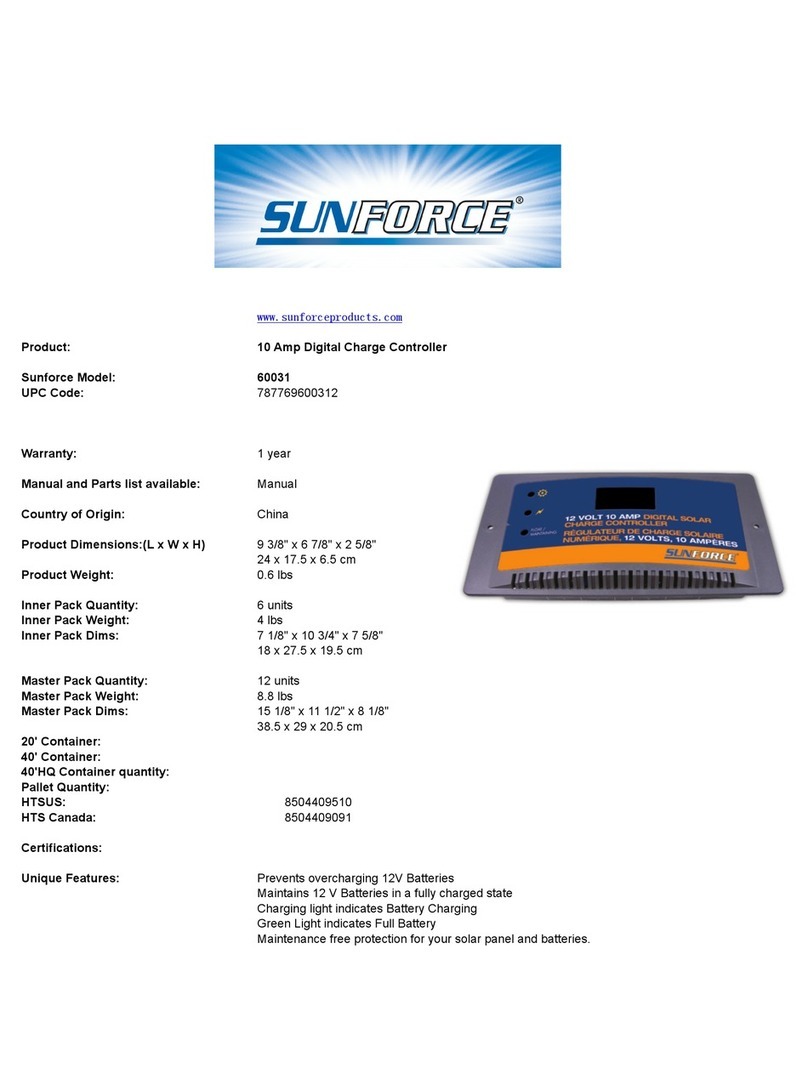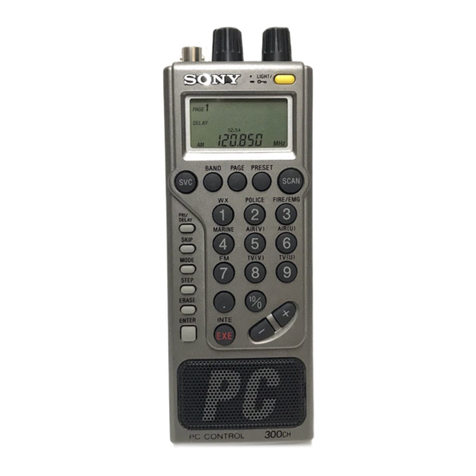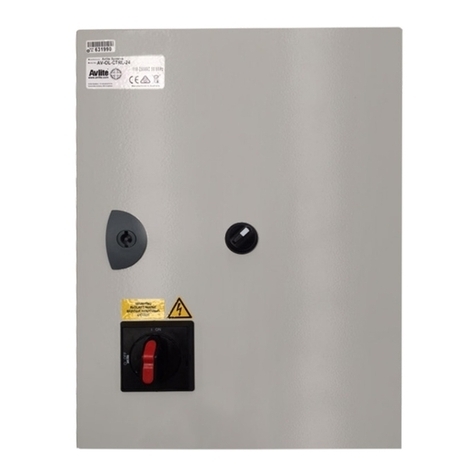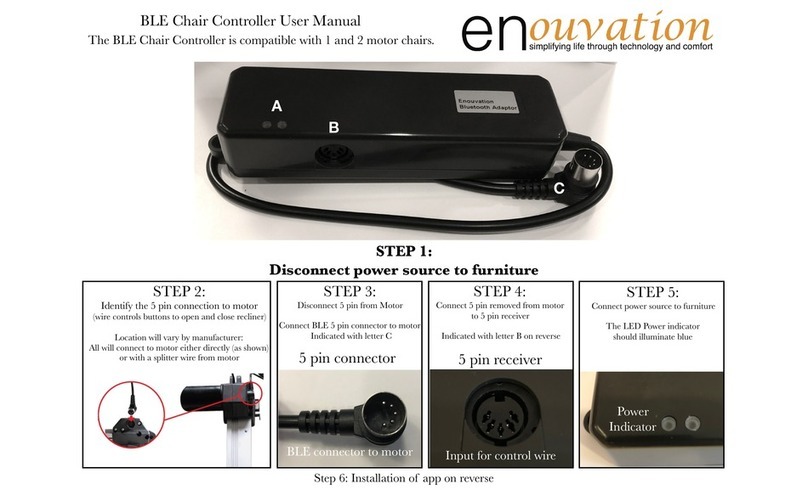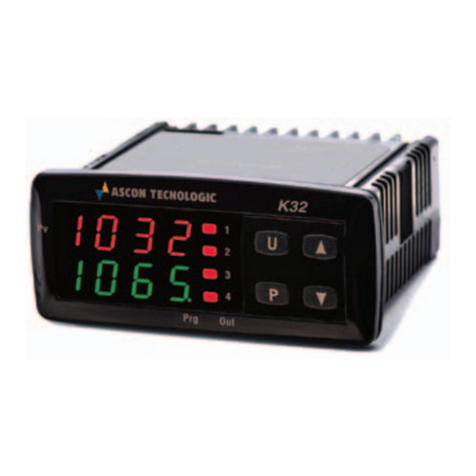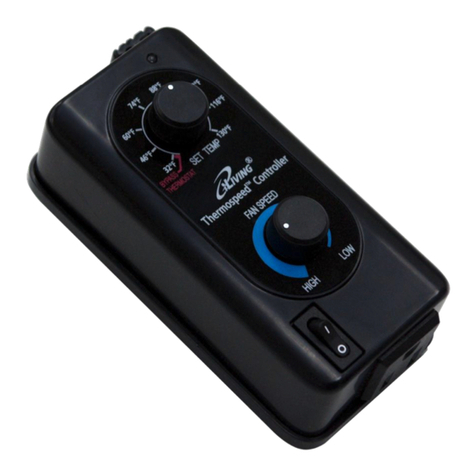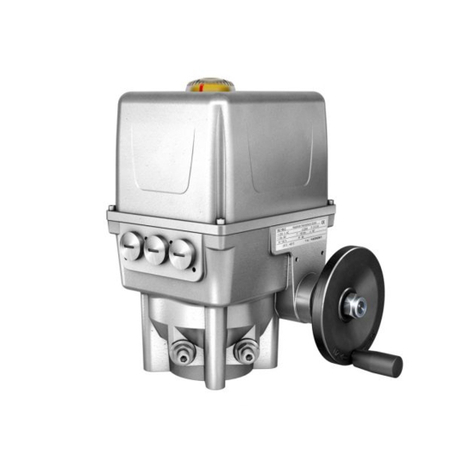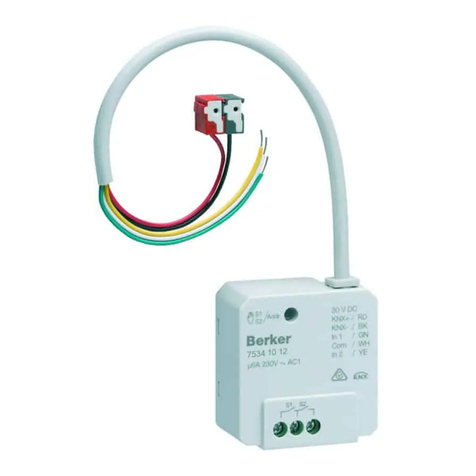Apeks TX100 User manual

TX SECOND STAGE
REGULATOR
TECHNICAL SUPPORT
APEKS MARINE EQUIPMENT LTD, NEPTUNE WAY, BLACKBURN, LANCASHIRE. BB1 2BT
MAINTENANCE MANUAL FOR
AUTHORISED TECHNICIANS
Document No. AP5833
Issue 4
15/02/2011

2
TX Second Stage Regulator Maintenance Manual
3
TX Second Stage Regulator Maintenance Manual
Change
No.
Change Re-
quest No.
Description & Comments: Change Date New Issue No. Changed By: Approved
By:
0832 -
statement about leftover items after servicing,
photos of tools added, metric & Imp Units and
note about AP2038/SQ
02/08/06 02 JLH ACD
0951 Page 11 and 18. Torque setting changed from
5Nm to 3Nm for T20 due to Case damage
problems.
12/01/09 03 MW RJP
1116 0247 All heat exchanger torque settings have been
changed from 5Nm to 3Nm to prevent damage
to the case. Add new O ring pick to tools list.
31/01/11 04 RH
AMENDMENTS RECORD:
Amendments and approval of this document can only be carried out by the relevant people listed on the Approved list of signatures, which
is listed in the Apeks Quality Manual. To instigate a change, a Task / Change request form, (Form No. ‘DESI/10002’), must be completed
and passed to the relevant person(s) for approval which are listed on the Approved List of Signatures. When approval has been granted and
recoreded this table can then be completed and the document up issued.
ACD

2
TX Second Stage Regulator Maintenance Manual
3
TX Second Stage Regulator Maintenance Manual
Contents
RANGE COVERED .................................................................................................................................................................... 4
COPYRIGHT NOTICE................................................................................................................................................................ 5
INTRODUCTION ........................................................................................................................................................................ 5
WARNINGS, CAUTIONS & NOTES ......................................................................................................................................... 5
SCHEDULED SERVICE ............................................................................................................................................................. 5
GENERAL GUIDELINES ........................................................................................................................................................... 5
GENERAL CONVENTIONS....................................................................................................................................................... 6
DISASSEMBLY PROCEDURES ................................................................................................................................................ 6
REASSEMBLY PROCEDURES.................................................................................................................................................. 9
FINAL TESTING ....................................................................................................................................................................... 12
TABLE 1 - TROUBLESHOOTING GUIDE ............................................................................................................................. 14
TABLE 2 - RECOMMENDED TOOL LIST.............................................................................................................................. 15
TABLE 3 - RECOMMENDED LUBRICANTS AND CLEANERS ........................................................................................ 16
CLEANING AND LUBRICATION PROCEDURE .................................................................................................................. 17
TABLE 4 -TORQUE SPECIFICATIONS .................................................................................................................................. 18
TABLE 5 - TEST BENCH SPECIFICATIONS ......................................................................................................................... 18
TX100 EXPLODED PARTS DRAWING .................................................................................................................................. 19
TX50 EXPLODED PARTS DRAWING .................................................................................................................................... 20
TX40 & T20 EXPLODED PARTS DRAWING......................................................................................................................... 21

4
TX Second Stage Regulator Maintenance Manual
5
TX Second Stage Regulator Maintenance Manual
RANGE COVERED
This manual provides factory prescribed procedures
for the correct maintenance and repair of the following
Apeks TX second stage regulator range.
TX100
Flagship model, features include: -
Adjustable cracking control
Integrated venturi control
Pneumatically balanced valve design
Suitable for cold water use
Satin Chrome Finish
TX50
Features include: -
Adjustable cracking control
Integrated venturi control
Pneumatically balanced valve design
Suitable for cold water use
Bright Chrome Finish
TX40
Features include: -
Integrated venturi control
Pneumatically balanced valve design
Suitable for cold water use
Bright Chrome Finish
T20
Features include: -
Integrated venturi control
Pneumatically balanced valve design
Bright Chrome Finish

4
TX Second Stage Regulator Maintenance Manual
5
TX Second Stage Regulator Maintenance Manual
An Ofcial Inspection consists of:
1. A pressurised immersion test of the entire unit to check for
air leakage.
2. Checking for stable medium pressure that is within the ac-
ceptable range.
3. Checking for opening effort that is within the acceptable
range.
4. Checking for smooth operation of the control knob and
venturi switch.
5. A visual inspection of any lters for debris or dis-
colouration.
6. A visual inspection of the exhaust valve(s) to see that they
are in good condition and that it is seating against a clean
and undamaged surface.
7. A visual inspection of the mouthpiece looking for tears or
holes and checking the general condition.
8. Pulling back hose protectors and checking that the hoses are
secure in the hose crimps.
If a regulator fails steps 1,2,3 or 4 the entire regulator should be
serviced. If a regulator fails 5,6 or 7 it will be at the technician’s
discretion whether or not a full service is required. Failure of step
8 requires replacement of the Hose.
GENERAL GUIDELINES
1. In order to correctly perform the procedures outlined in
this manual, it is important to follow each step exactly in
the order given. Read over the entire manual to become
familiar with all procedures and to learn which specialty
tools and replacement parts will be required before
commencing disassembly. Keep the manual open beside
you for reference while performing each procedure. Do not
rely on memory.
2. All service and repair should be carried out in a work area
specically set up and equipped for the task. Adequate
lighting, cleanliness, and easy access to all required tools are
essential for an efcient repair facility.
3. During disassembly, reusable components should be
segregated and not allowed to intermix with non-reusable
parts or parts from other units. Delicate parts, including
inlet ttings and valve seats which contain critical sealing
surfaces, must be protected and isolated from other parts to
prevent damage during the cleaning procedure.
4. Use only genuine Apeks parts provided in the 2nd stage
service kit (AP0219). DO NOT attempt to substitute an
Apeks part with another manufacturer’s, regardless of any
similarity in shape or size. Please note that AP0219 is a
generic kit that covers several different types of 2nd stage
and therefore not all of the parts within the kit will be used
when servicing a TX 2nd stage.
5. Do not attempt to reuse mandatory replacement parts
under any circumstances, regardless of the amount of use
the product has received since it was manufactured or last
serviced.
6. When reassembling, it is important to follow every torque
specication prescribed in this manual, using a calibrated
torque wrench. Most parts are made of either marine brass
or plastic, and can be permanently damaged by undue stress.
COPYRIGHT NOTICE
This manual is copyrighted, all rights reserved. It may not,
in whole or in part, be copied, photocopied, reproduced,
translated, or reduced to any electronic medium or machine
readable form without prior consent in writing from Apeks
Marine Equipment Ltd. It may not be distributed through the
internet or computer bulletin board systems without prior
consent in from Apeks Marine Equipment Ltd.
©2006 Apeks Marine Equipment Ltd.
TX Second Stage Maintenance Manual
(AP5833 Issue 2)
INTRODUCTION
This manual provides factory prescribed procedures for the correct
maintenance and repair of the Apeks TX second stage regulator
range. It is not intended to be used as an instructional manual for
untrained personnel. The procedures outlined within this manual
are to be performed only by personnel who have received factory
authorised training through an Apeks Service & Repair Seminar. If
you do not completely understand all of the procedures outlined
in this manual, contact Apeks to speak directly with a Technical
Advisor before proceeding any further.
WARNINGS, CAUTIONS & NOTES
Pay special attention to information provided in warnings,
cautions, and notes that are accompanied by one of these
symbols:
WARN I N G S indicate a procedure or situation
that may result in serious injury or death if
instructions are not followed correctly.
CAUTIONS indicate any situation or technique
that will result in potential damage to the
product, or render the product unsafe if
instructions are not followed correctly.
NOTES are used to emphasise important points, tips,
and reminders.
SCHEDULED SERVICE
It is recommended that the Apeks TX second stage regulator should
be serviced annually regardless of usage.
However, If you are at all unsure about the correct functioning of the
Apeks TX, then it must be ofcially inspected immediately.
All service and inspection details need to be documented
in the Regulator Service Record in the back of the Owner’s
Manual to keep the Limited Lifetime Warranty in effect.

6
TX Second Stage Regulator Maintenance Manual
7
TX Second Stage Regulator Maintenance Manual
1. Using two 11/16” spanners, hold the Heat Exchanger (6)
stationary while turning the Hose Swivel anti-clockwise.
Remove the ‘O’ ring from inside the Hose Swivel. Exercise
caution not to scratch the ‘O’ ring groove. Remove the ‘O’
ring from the male end of the Hose.
Pinch Method
Press upwards on
sides of ‘O’ Ring to
create a protrusion.
Grab ‘O’ Ring or
insert ‘O’ Ring tool
at protrusion.
2. Pull back the two
Hose Protectors and
inspect the Hose
Crimps. If either
Crimp is damaged or
the Hose is pulling
out of the crimp then
the Hose must be
replaced.
3. Using the Apeks Front Cover Tool (PN AT31), unscrew the
Case Cover (4). To remove the Purge Button and Spring (2
& 3), squeeze two opposite tabs inward.
NOTE: Ensure that the tool is rmly pressed against
the Case Cover whilst unscrewing.
Removal of hose
Removal of diaphragm
GENERAL CONVENTIONS
Unless otherwise instructed, the following terminology and
techniques are assumed:
1. When instructed to remove, unscrew, or loosen a
threaded part, turn the part anti-clockwise.
2. When instructed to install, screw in, or tighten a
threaded part, turn the part clockwise.
3. When instructed to remove an ‘O’ Ring, use the pinch
method (see gure below) if possible, or use a brass,
aluminium or plastic ‘O’ Ring removal tool. Avoid using
hardened steel picks, as they may damage ‘O’ Ring
sealing surfaces. All ‘O’ Rings that are removed are
discarded and replaced with brand new ‘O’ Rings.
4. The following acronyms are used throughout the
manual: MP is Medium Pressure; HP is High Pressure;
PN is Part Number.
5. Numbers in parentheses reference the key numbers
on the exploded parts schematics. For example, in the
statement, “...remove ‘O’ ring (4) from...”, the number 4
is the key number to the Spring Carrier ‘O’ Ring.
DISASSEMBLY PROCEDURES
NOTE: Before performing any disassembly, refer
to the exploded parts drawing, which references all
mandatory replacement parts. These parts should be
replaced with new, and must not be reused under any
circumstances - regardless of the age of the regula-
tor or how much use it has received since it was last
serviced.
CAUTION: Use only a plastic, brass or aluminium
‘O’ Ring removal tool (PN AT79) when removing
‘O’ Rings to prevent damage to the sealing surface.
Even a small scratch across an ‘O’ Ring sealing
surface could result in leakage. Once an ‘O’ Ring
sealing surface has been damaged, the part must be
replaced with new. DO NOT use a dental pick, or
any other steel instrument.

6
TX Second Stage Regulator Maintenance Manual
7
TX Second Stage Regulator Maintenance Manual
4. Lift out the Diaphragm
Cover (5) and Diaphragm
(7).
5. Using an 11/16”
spanner, remove the
Heat Exchanger (6).
6. Turn the Counterbalance Adjuster Knob (28) anti-clockwise
until it stops. For the TX40 and T20 models use an Allen
key to turn the Adjusting Screw (28). Press the Lever (19)
against the Valve Spindle (20). While keeping the Lever
depressed, grasp the Knob and pull the Valve Spindle
assembly out of the Case (9). Remove the Valve Spindle ‘O’
ring (8) that will probably be left behind in the left side of
the Case.
7. Grasp the Venturi Lever (14) and pull it out of the
Case. Remove the ‘O’ ring (13) from the Venturi Lever.
8. Turn the
Counterbalance
Adjuster Knob (28) or
Adjusting Screw (28)
clockwise (inward) one
turn. The Spring Pin
(21) should drop out. If
the Pin remains in the
Valve Spindle, use a
1/16” dowel or punch
to push it partially out,
then use needlenose
pliers to completely
remove it from the
valve spindle.
9. Unscrew the Counterbalance Adjuster Knob (28) or
Adjusting Screw (28) and completely remove it from the
Valve Spindle.
10. Remove the ‘O’ ring (27) from the Counterbalance Adjuster
Knob. Remove the ‘O’ ring (8) from the Valve Spindle
Removal of valve assembly
NOTE: The Venturi Lever may have come out with
the valve Spindle in step 6. If this is the case, depress
the Lever and slide the Venturi Lever off from right to
left.
11. Insert a small 1/8” wooden dowel into the threaded end of
the Valve Spindle and push out the Shuttle Valve assembly
(22-26). Separate the Shuttle Valve assembly by pulling on
each end.

8
TX Second Stage Regulator Maintenance Manual
9
TX Second Stage Regulator Maintenance Manual
13. Using a Slotted Seat Adjuster (PN AT51), turn the Seat (17)
six to seven full turns anti-clockwise. Since the Seat is ‘O’
ring sealed, it will not completely unscrew from the Valve
Spindle. Insert a pair of external circlip pliers into the Valve
Spindle, and pull the Seat completely out. Remove the ‘O’
ring (18) from the Seat.
This Ends Disassembly
Before starting reassembly, perform parts cleaning
and lubrication according to the procedures
outlined in ‘Cleaning & Lubrication’ on page 15.
NOTE: If the Exhaust Valve (15) is to be removed, pinch
edge of Exhaust Valve and pull tail through hole in Case
(9).
Inspection and Removal of Exhaust Valve
Removal of mouthpiece
14. To remove the Exhaust Tee (16), squeeze the two exhaust
ports (see picture) together. Pull the Tee away from the Case
(9).
15. Fold back the edges of the Exhaust Valve (15) and inspect
underneath. The seating surface should be clean and free of
damage. Inspect the Exhaust Valve. It should be supple and
have well dened edges. If it looks good, there is no need
to remove it and it may be reused. If there is any sign of
deterioration, it should be replaced.
16. Using side cutters, snip the Mouthpiece Clip (11). Remove
the mouthpiece (12).
12. Using a ngernail, remove the Rubber Seating (22) and
small ‘O’ ring (24) from the Shuttle Valve.

8
TX Second Stage Regulator Maintenance Manual
9
TX Second Stage Regulator Maintenance Manual
REASSEMBLY PROCEDURES
1. If the Exhaust Valve (15) was removed, replace by threading
the tail through the retaining hole on the outside of the Case
(9) until the barb engages on the inside. Align the rib so it is
horizontal. If the Valve is new, cut off the excess stem with
side cutters leaving approximately 5mm (0.196”) of the tail
behind.
2. Orientate the Exhaust Tee (16) with the Case (9). Clip one
corner of the Tee onto the Case. Stretch the other corner
over the Case and then stretch the bottom of the Tee onto
the Case.
3. Install a new, lubricated
‘O’ Ring (8) onto the
Valve Spindle. (20).
4. Press a new, lubricated ‘O’ ring (24) onto the stem of the
Shuttle Valve (23). Press a new Rubber Seating (22) into
the front of the Shuttle Valve.
5. Fit the Valve Spring (25) onto the leading edge of the
Counterbalance Cylinder (26). Carefully guide the stem
of the Shuttle Valve through the Spring and into the
Fitting Exhaust Valve and Exhaust Valve Cover
Assembling and tting valve assembly
WARNING: Flooding may occur if the tail of
the valve is not fully pulled through. Check
that barb has engaged on inside of Case.
NOTE: Ensure Rubber Seating has been tted ush
with Shuttle Valve.
CAUTION: Ensure that Lever is not twisted
and that legs are parallel. Lever should
appear as that shown on the left, not as
shown on the right. If necessary, gently
squeeze legs together to straighten.
Counterbalance Cylinder.
6. If you removed the Lever, replace it so that it points
upwards when the air outlet hole points to the left with the
threaded end facing you.

10
TX Second Stage Regulator Maintenance Manual
11
TX Second Stage Regulator Maintenance Manual
Spindle.
8. Install a new, lubricated ‘O’ ring (27) onto the
Counterbalance Adjuster Knob.
9. Install the Counterbalance Adjuster Knob into the Valve
Spindle. There should now be spring tension on the Lever.
Continue to screw clockwise until the holes for the Spring
Pin are clear. Install the Spring Pin (21). Be sure that it
sits evenly in the hole. Back the Adjuster Knob out anti-
clockwise to apply tension to the Pin and keep it from
falling out.
10. Install a new, lubricated ‘O’ ring (13) onto the Venturi Lever
(14). Point the Venturi Lever upward and insert it into the
Case. Press it against the Case so the ‘O’ ring is captured.
7. With the “feet” of the Shuttle Valve pointing downward
(away from the Lever) and the Lever pointing straight
up (perpendicular to the Valve Spindle), insert the Valve
assembly into the Valve Spindle. Using your nger, press
the Shuttle Valve assembly all the way into the Valve
NOTE: Ensure that the Lever has a full range of
movement and does not catch on the Valve Spindle.
11. While depressing the Lever, insert the Valve Spindle
through the Venturi Lever and into the Case. Be sure
that the two ats and the two Lever feet engage in the
tabs moulded into the Case .

10
TX Second Stage Regulator Maintenance Manual
11
TX Second Stage Regulator Maintenance Manual
12. Slide a new, lubricated ‘O’ ring (8) down the threaded
end of the Valve Spindle. Screw the Heat Exchanger (6),
hexagon facing outward, onto the Valve Spindle until nger
tight. Using an 11/16” crows foot or deep socket, tighten to
a torque of 3 Nm (2.2 lbf/ft).
13. Fit a new, lubricated ‘O’ ring (18) onto the Seat (17). Press
the Seat, threaded end rst, into the Valve Spindle. Using
the Slotted Seat Adjuster Tool, push the Seat into the Valve
Spindle as far as it will go.
14. While holding the rim of the Case at eye level, turn the
Seat in (clockwise) until the Lever drops about 4mm
((0.157”)below the Case rim. Then, turn the Seat anti-
clockwise until the Lever is level with the Case rim.
CAUTION: Ensure Diaphragm is seated correctly
and not creased.
16. Place the small diameter end of the Spring (3) onto the
Purge Button (2). Orient the Case Cover with the slotted
openings pointing to the right. Properly align the Purge
Button and press it into the Case Cover until it snaps into
place.
Fitting Diaphragm
Before tting hose, carry out suction test by holding thumb
over Valve Spindle (20) to seal and trying to breathe
through mouthpiece outlet port. No air should be drawn in.
17. Screw the Case Cover (4) onto the Case. Using the Cover
Tool (p/n AT31) tighten the Cover until it stops. Conrm
that the Purge Button is properly aligned.
CAUTION: Excessive tightening of the Heat
Exchanger will damage the two ats inside the case.
15. Position the Diaphragm (7) into the Case (9). Using your
nger, work the edges of the Diaphragm into place so it sits
evenly in the Case . Install the Diaphragm Cover (5) into the
Case, over the Diaphragm.
CAUTION: Ensure that the Lever is vertical after
tightening.

12
TX Second Stage Regulator Maintenance Manual
13
TX Second Stage Regulator Maintenance Manual
FINAL TESTING
Setting the Lever Height
1. Connect the rst stage regulator to a calibrated test bench and
pressurise the system to 200 bar (±10) or 2900 psi (±145).
Connect an intermediate pressure gauge to the rst stage
regulator and ensure that the I.P. is set to 9.5 bar (±0.5) or
137 psi (±7.2). Make sure that the Adjuster Knob (28) is fully
wound out and that the Venturi Lever (14) is set to the “+”
position.
2. Tap the purge button quickly, this will cause the
regulator to freeow. Stop the freeow after a couple of
seconds by placing a hand over the mouthpiece.
3. Place the NO Gas Flow end of the TX Setting Tool (AT69
for all models except the TX100 or AT70 for the TX100)
onto the purge button decal (1). Depress the Purge button
by pushing the tool towards the 2nd stage until it stops
against the Front cover. If no gas ows from the second stage
proceed to step 5. If gas ows from the valve follow step 4.
4. Disconnect the second stage from the hose as shown in
step 1 of the disassembly procedure. Using the Slotted Seat
Adjuster Tool (PN AT51) , turn the seat (17) clockwise by
approximately 1/16 of a turn. Repeat step 3.
5. Place the Gas Flow end of the TX Setting Tool onto the purge
button decal (1). Depress the Purge button by pushing the
tool towards the 2nd stage until it stops against the Front
cover. If gas ows from the second stage the lever height has
been set correctly. If no gas ows from the valve proceed to
step 6.
6. Disconnect the second stage from the hose as shown in
step 1 of the disassembly procedure Using the Slotted Seat
Adjuster Tool (PN AT51) , turn the seat (17) anti-clockwise
by approximately 1/16 of a turn. Repeat both step 3 and step
5.
(Testing is continued on the next page)
Fitting Hose and Mouthpiece
WARNING: Ensure that the Mouthpiece is
properly secured on the outlet port.
NOTE: If your facility is equipped with a test bench,
perform the tests before installing the mouthpiece.
General instructions for performing bench tests are
located in the next section, “Final Testing.”
19. Screw the Hose onto the second stage. Using an 11/16”
crows-foot on a torque wrench and a spanner on the Heat
Exchanger, tighten the Hose to 5 Nm (3.7 lbf/ft).
18. Add a new ‘O’ ring to the male end of the Hose. Install a
new, lubricated ‘O’ ring into the swivel end of the Hose.
20. If equipped with a comfo-bite Mouthpiece, make sure the
‘bridge’of the Mouthpiece (12) is facing upward. Stretch
the Mouthpiece over the second-stage Mouthpiece outlet
port. At the base of the Mouthpiece is a groove for the
Mouthpiece Clip (11). Wrap the Clip around the Mouthpiece
so that the buckle points toward the Hose. Tighten the Clip
and snip the excess with side cutters.
NOTE: An inline adjuster can be used can be used as
shown below. This allows the seat (17) to be adjusted
without having to disconnect the second stage from the
hose.

12
TX Second Stage Regulator Maintenance Manual
13
TX Second Stage Regulator Maintenance Manual
FINAL TESTING (CONTINUED)
External Leak Test
1. After disconnecting the regulator from the ow bench,
connect it to a SCUBA cylinder lled to approximately 200
bar or 2900 psi. Open the cylinder valve to repressurise the
regulator, and submerge the entire system in a test tank of
clean water.
2. Observe any bubbles arising from the submerged
regulator over a one minute period. The recommended
time is necessary due to slower bubble formation
that occurs in smaller leaks. Bubbles indicate a leak,
which requires the system to be disassembled at the
source to check sealing surfaces, assembly sequence
and component positioning in order to correct the
problem(s).
NOTE: Extremely small leaks may be better detected
by applying a soap solution or Snoop™ to the leak
area. Bubble streams will indicate the source of the
leak. Before disassembling to correct any leaks,
rinse the entire regulator thoroughly with fresh water
and blow out all residual moisture with ltered, low-
pressure air. Disassemble and remedy the problem,
referring to “Table 1 - Troubleshooting.”
Subjective Breathing Test
1. Depress the Purge Button fully to ensure that an
adequate volume of air needed to clear the second
stage ows through the mouthpiece. Then, inhale
slowly but deeply from the mouthpiece. A properly
serviced and adjusted regulator should deliver air upon
deep inhalation without excessive inhalation effort,
freeow, or “uttering” of the second-stage diaphragm.
When exhaling, there should be no uttering or sticking
of the exhalation valve. If any of these problems occur,
refer to “Table 1 - Troubleshooting”.
This Ends Reassembly

14
TX Second Stage Regulator Maintenance Manual
15
TX Second Stage Regulator Maintenance Manual
Table 1 - Troubleshooting Guide
SYMPTOM POSSIBLE CAUSE TREATMENT
Leakage or freeow from TX Second
Stage
1. Excessively high rst-stage intermediate
pressure.
1. Refer to rst-stage Troubleshooting
Guide.
2. Rubber Seating (24) damaged or worn. 2. Replace Rubber Seating.
3. Seat (17) adjusted incorrectly, Lever
(19) set too high.
3. Reset Seat preliminary settings, and
repeat Adjustment Procedures.
4. Lever (19) bent. 4. Replace Lever.
5. Seat (17) sealing surface damaged. 5. Replace Valve Seat.
6. Valve Spring (25) damaged. 6. Replace Spring.
7. Shuttle Valve ‘O’ Ring (24) damaged. 7. Replace ‘O’ Ring.
8. Counter Balance Cylinder (26) bore
damaged. 8. Replace Counter Balance cylinder.
Low purge or excessive work of
breathing (full cylinder)
1. Low rst-stage intermediate pressure. 1. Refer to rst-stage Troubleshooting
Guide.
2. Seat (17) adjusted incorrectly, Lever
(19) set too low.
2. Reset Seat preliminary settings, and
repeat Adjustment Procedures.
3. Intermediate pressure hose clogged or
obstructed. 3. Clean or replace Hose.
4. Lever (19) bent or catching on Valve
Spindle (20). 4. Replace Lever.
Water entering TX Second Stage
1. Mouthpiece (12) damaged or incorrectly
tted.
1. Replace or re-t Mouthpiece as
appropriate.
2. Diaphragm (7) damaged. 2. Replace Diaphragm.
3. Diaphragm (7) improperly seated in
Case (9).
3. Remove Front Cover (4) and
Diaphragm Cover (5) properly
reassemble Diaphragm (check for
distortion).
4. Exhaust Valve (15) damaged. 4. Replace Exhaust Valve.
5. Case (9) damaged. (Check exhaust valve
seating surface.) 5. Disassemble and replace Case.
6. Heat exchanger ‘O’ Ring (8) damaged. 6. Replace ‘O’ Ring.

14
TX Second Stage Regulator Maintenance Manual
15
TX Second Stage Regulator Maintenance Manual
Table 2 - Recommended Tool List
PART NO. DESCRIPTION APPLICATION
AP0430 I.P. test gauge Intermediate pressure testing
AT79 ‘O’ Ring removal pick ‘O’ Ring removal
AT31 Front Cover Tool Case Cover removal and installation
AT51 Slotted Seat Adjuster Removal and installation of Seat
n/a Torque wrench, Nm or lbf/ft Hose and Heat Exchanger
n/a 11/16” adapter for torque wrench Hose and Heat Exchanger
AT34 11/16” spanner 2 off Heat Exchanger
AT37 5mm Allen key Removal of Spring adjuster (TX40 & T20 only)
n/a Side cutters Zip Tie, Exhaust Valve
AT24 Internal Circlip Pliers Removal of Seat
AT70 TX100 Setting Tool Setting of Lever Height
AT69 TX50, 40 & T20 Setting Tool Setting of Lever Height
AP0430 AT79 AT31 AT51
AT34 AT37 AT24 AT70
AT69

16
TX Second Stage Regulator Maintenance Manual
17
TX Second Stage Regulator Maintenance Manual
Table 3 - Recommended Lubricants & Cleaners
LUBRICANT / CLEANER APPLICATION SOURCE
Christo-Lube® MCG-111
(Lubricant)
All ‘O’ Ring seals Apeks Marine Equipment Ltd
PN AP1495, or
Lubrication Technologies
310 Morton Street
Jackson, OH 45640, USA
(800) 477-8704
Biox
(Cleaning agent)
Biological immersion uid for reusable
stainless steel and brass parts.
Solent Divers Ltd
122-128 Lake Rd, Portsmouth,
Hants, PO1 4HH
White distilled vinegar (100 gr.)
(Cleaning agent)
Acid bath for reusable stainless
steel and brass parts.
“Household” grade
Liquid dishwashing detergent diluted
with warm water
(Cleaning agent)
Degreaser for brass and stainless steel
parts; general cleaning solution for
plastic and rubber
“Household” grade
CAUTION: Silicone rubber requires no lubrication or preservative treatment. DO NOT
apply grease or spray to silicone rubber parts (eg. Diaphragm, Exhaust Valves.) Doing so
may cause a chemical breakdown and premature deterioration of the material.
CAUTION: Do not use muriatic acid for the cleaning of any parts. Even if strongly diluted,
muriatic acid can harm chrome plating and may leave a residue that is harmful to ‘O’ Ring
seals and other parts

16
TX Second Stage Regulator Maintenance Manual
17
TX Second Stage Regulator Maintenance Manual
Cleaning & Lubrication Procedure
General Cleaning of all Parts
1. Place all components in an ultrasonic cleaning bath containing an appropriate cleaning solution, such as Biox.
2. The components should be cleaned for 6 minutes, depending upon their condition. Longer cleaning times may used if
required.
3. Rinse the components in warm fresh water.
4. The components should then be blown dry or left to dry naturally.
Lubrication and Dressing
All ‘O’ Rings should be lubricated with Christo-Lube® MCG-111. Dress the ‘O’ Rings with a very light lm of grease, and remove any
visible excess by running the ‘O’ Ring between thumb and forenger. Avoid applying excessive amounts of Christo-Lube grease, as
this will attract particulate matter that may cause damage to the ‘O’ Ring.
Nitrox
When it comes to issues of nitrox safety and compatibility, the concerns lie primarily with the rst stage as it is subjected to high
inlet pressures. High inlet pressures lead to adiabatic compression or heating of the gas. As they leave the factory, standard Apeks
regulators are suitable for use with oxygen enriched gases (i.e. nitrox, etc.) providing the oxygen content does NOT EXCEED 40%
(EAN40).
Any Apeks regulator, when properly cleaned, lubricated and assembled, is authorised for use with enriched air nitrox (EAN) up
to 100% (EAN100). It is authorised because it has undergone adiabatic compression testing and the authorised service kit com-
ponents and lubricants are compatible in elevated oxygen environments. During cleaning, a mild detergent is used to remove
condensed hydrocarbons (compressor oils) from the inside passageways of the rst stage. For the rst stage to remain EAN100
compatible, only use hyperltered compressed gas (hydrocarbons < 0.1 mg/m3). Ordinary compressed breathing air to BS EN
12021:1999 does not meet this criteria. Once ordinary breathing air is used, the rst stage is no longer EAN100 compatible until it is
cleaned and serviced again.
Although regulator second stage components are not exposed to high pressure EAN, Apeks recommends that the same cleaning
procedures be followed for the complete regulator. This prevents the possibility of cross contamination and guarantees the
cleanliness of the entire regulator.
WARNING: Please check the regulations regarding Nitrox in your particular country as this may differ
from Apeks standard policy.

18
TX Second Stage Regulator Maintenance Manual
19
TX Second Stage Regulator Maintenance Manual
Table 5 - Test Bench Specications
TEST CONDITION ACCEPTABLE RANGE
Opening Effort
High Pressure > 50 bar gauge (725 psi)
Medium pressure 9.5±0.5 bar (137±7.2
psi)
+1.0 to +1.5 in. H20 (+25.4 to +38.1 mm.
H20)
External Leak
High Pressure > 50 bar gauge (725 psi)
Medium Pressure 9.5±0.5 bar (137±7.2
psi)
No Leaks allowed
Table 4 - Torque Specications
PART NUMBER DESCRIPTION / KEY NUMBER TORQUE
AP5013/S, AP5002, Heat Exchanger (6), 3 Nm / 2.2 lbf/ft
AP5003 Spacer (6) 3Nm / 2.2 lbf/ft
AP0203 Hose 5 Nm / 3.7 lbf/ft

18
TX Second Stage Regulator Maintenance Manual
19
TX Second Stage Regulator Maintenance Manual
1 AP5015 Decal 16 AP2040 Exhaust Tee
2 AP2053 Purge Button 17 AP2033 Seat
3 AP2020 Spring 18* AP1154 ‘O’ Ring
4 AP5326 Case Cover 19 AP2035 Lever
5 AP2025 Diaphragm Cover 20 AP2028/S Valve Spindle
6 AP5013/S Heat Exchanger 21 AP1151 Spring Pin
7 AP2023 Diaphragm 22* AP2034 Rubber Seating
8* AP1267 ‘O’ Ring 23 AP2036 Shuttle Valve
9 AP5100 Case 24* AP2041 ‘O’ Ring
10 AP2037 Deector 25 AP2021 Spring
11* AP1677 Mouthpiece Clip 26 AP2038 Counter Balance Cylinder (Long)
12 AP5324 Comfobite Mouthpiece ** AP2038/SQ Counter Balance Cylinder (Short)
13* AP1438 ‘O’ Ring 27* AP1409 ‘O’ Ring
14 AP5339 Venturi Lever 28 AP2029-2/S Adjusting Screw
15 AP1429 Exhaust Valve 29 AP2030 Plug
TX100 Exploded Parts Diagram
* All marked items must be replaced when serviced.
** AP2038/SQ Canada, USA & South America Only

20
TX Second Stage Regulator Maintenance Manual
21
TX Second Stage Regulator Maintenance Manual
TX50 Exploded Parts Diagram
* All marked items must be replaced when serviced.
1 AP5004/1 Decal 16 AP2040 Exhaust Tee
2 AP2053 Purge Button 17 AP2033 Seat
3 AP2020 Spring 18* AP1154 ‘O’ Ring
4 AP2026 Case Cover 19 AP2035 Lever
5 AP2025 Diaphragm Cover 20 AP2028 Valve Spindle
6 AP5002 Heat Exchanger 21 AP1151 Spring Pin
7 AP2023 Diaphragm 22* AP2034 Rubber Seating
8* AP1267 ‘O’ Ring 23 AP2036 Shuttle Valve
9 AP5001 Case 24* AP2041 ‘O’ Ring
10 AP2037 Deector 25 AP2021 Spring
11* AP1677 Mouthpiece Clip 26 AP2038 Counter Balance Cylinder (Long)
12 AP1434 Mouthpiece ** AP2038/SQ Counter Balance Cylinder (Short)
13* AP1438 ‘O’ Ring 27* AP1409 ‘O’ Ring
14 AP2039 Venturi Lever 28 AP2029 Adjusting Screw
15 AP1429 Exhaust Valve 29 AP2030 Plug
** AP2038/SQ Canada, USA & South America Only
This manual suits for next models
3
Table of contents
Other Apeks Controllers manuals
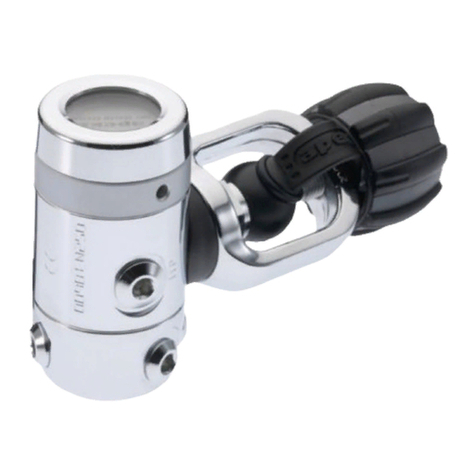
Apeks
Apeks DST User manual
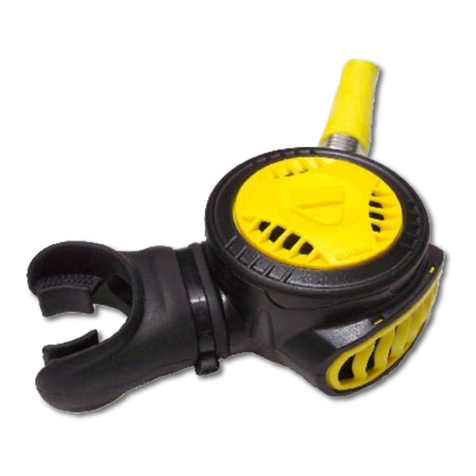
Apeks
Apeks Egress User manual
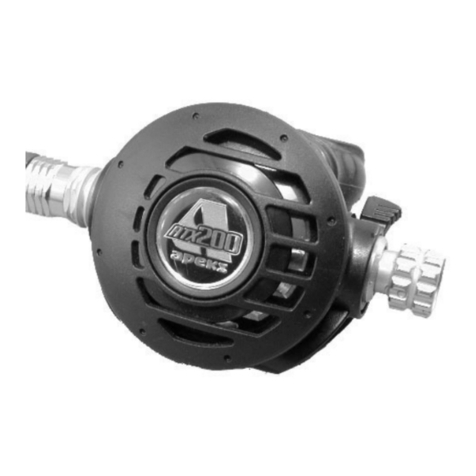
Apeks
Apeks ATX Second Stage User manual
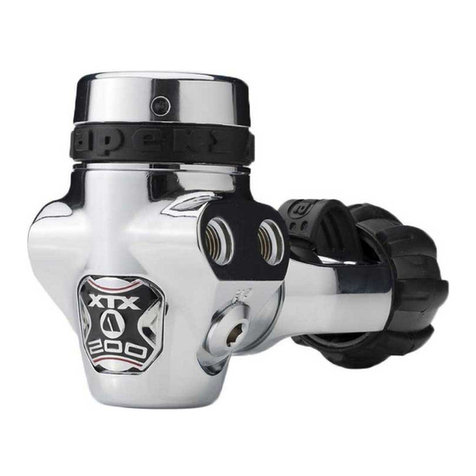
Apeks
Apeks FSR Series User manual
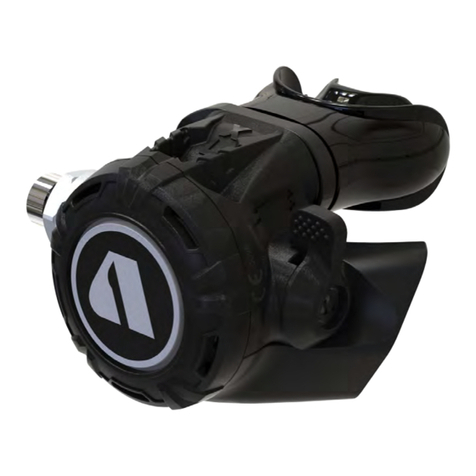
Apeks
Apeks XL4 SECOND STAGE User manual
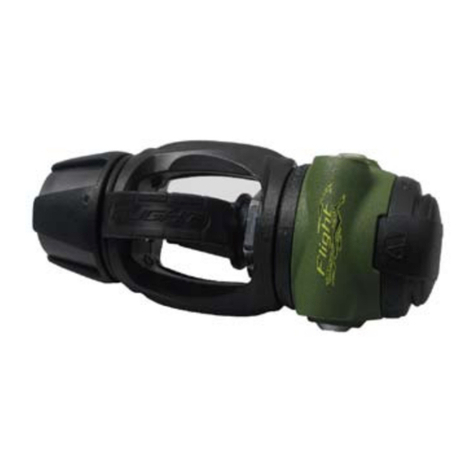
Apeks
Apeks Flight User manual
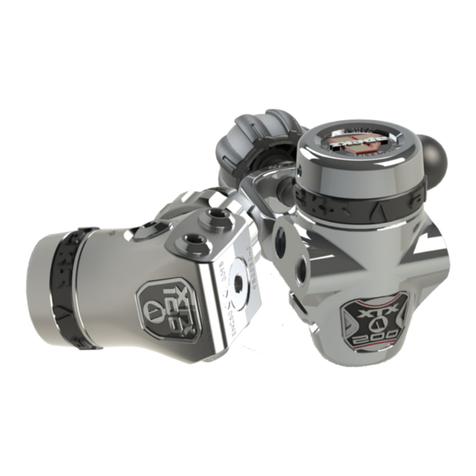
Apeks
Apeks XTX FSR User manual
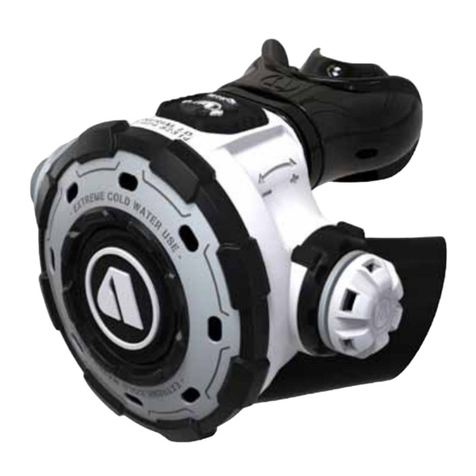
Apeks
Apeks MTX-R User manual
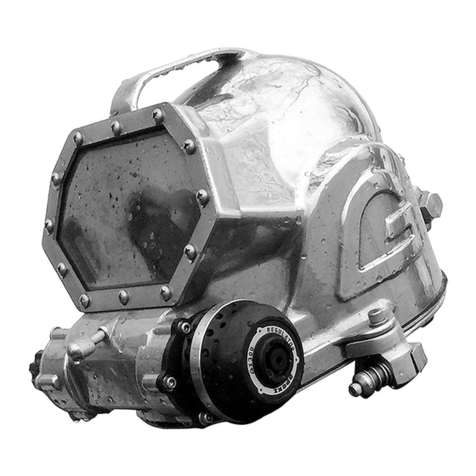
Apeks
Apeks GX300 User manual

Apeks
Apeks TEK3/XTX50 User manual
Popular Controllers manuals by other brands
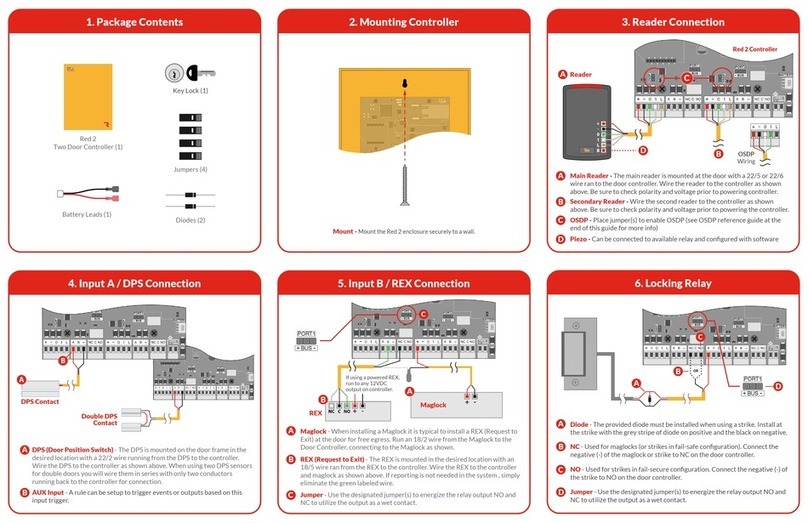
PDK
PDK RED 2 quick start guide
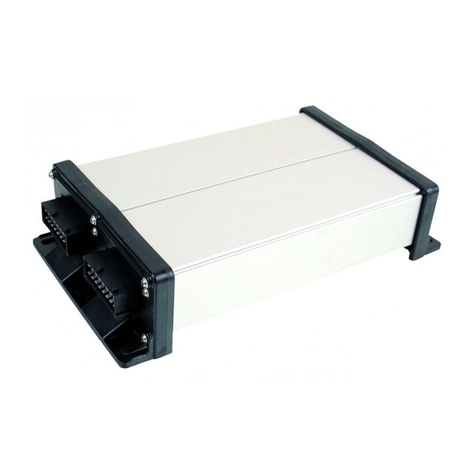
Muller Elektronik
Muller Elektronik SPRAYER-Controller Orchard/Vineyard MIDI 3.0 operating instructions

Vector
Vector TCI-W11-H overview
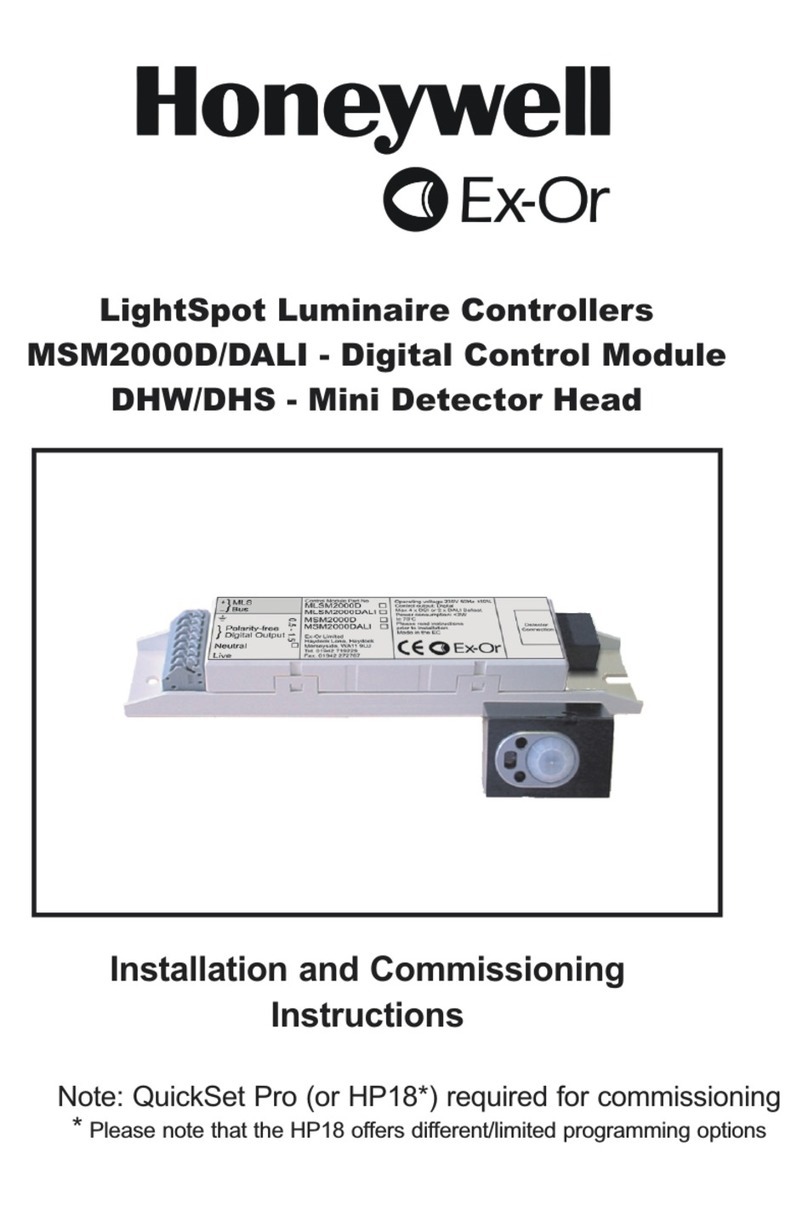
Honeywell
Honeywell Ex-Or MSM2000D Installation and commissioning instructions
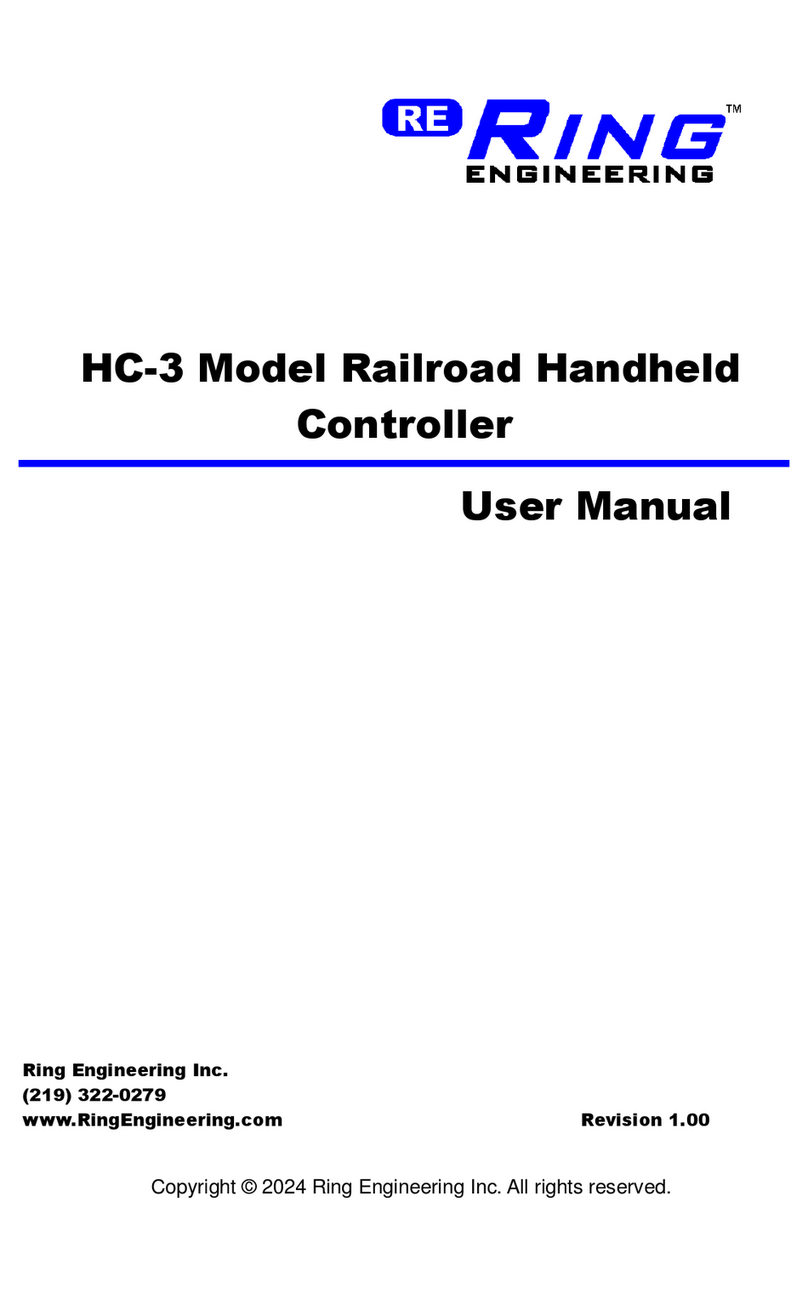
ring
ring HC-3 user manual
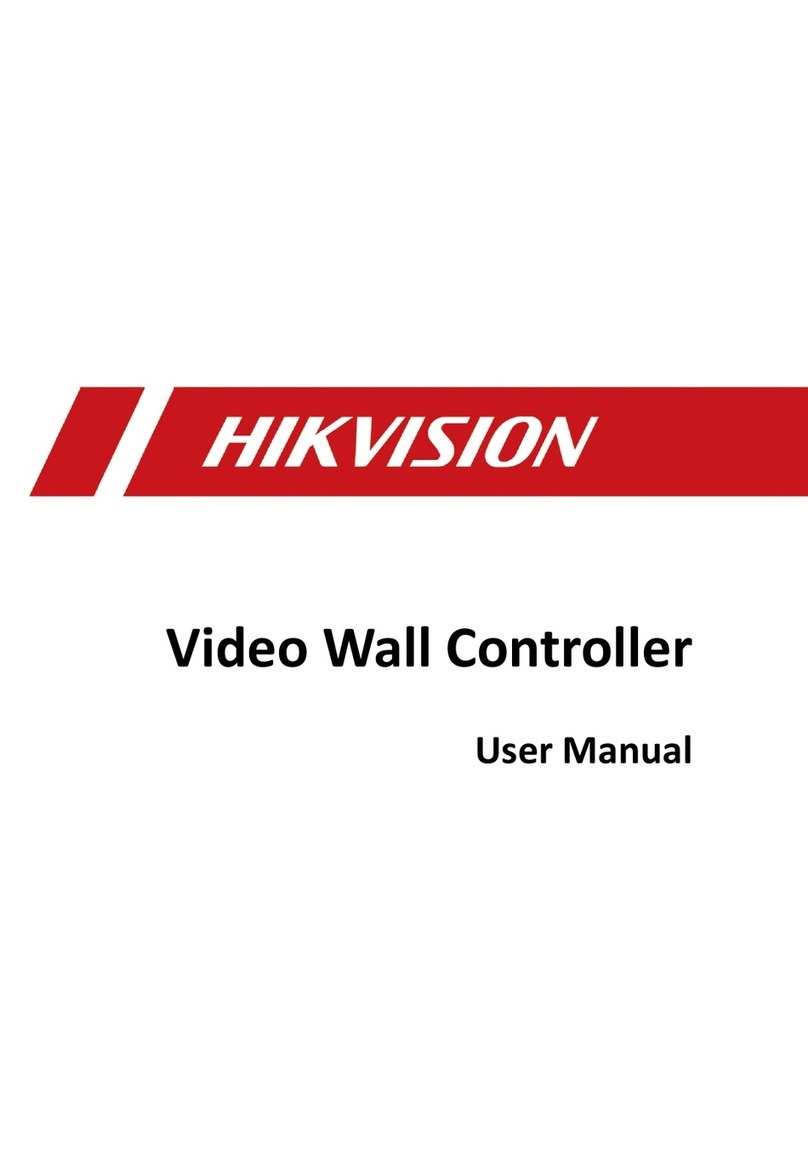
HIK VISION
HIK VISION DS-C12L Series user manual


